Early Power Substations and Switching Stations
Background There are a few types of high voltage substations used by the DWP which act as a bridge between power plants and local distribution. The principal type is called a receiving station. High voltage AC lines, typically from 115,000 volts to 230,000 volts, coming from power plants, enter the grid at receiving stations, where the voltage is stepped down to 34,500 volts or less, in long transformer banks. From there, the power is sent via underground or above-ground wires to surrounding distributing stations, which reduce the current further to send to customers.*# In addition to the receiving stations, there are a few switching stations in the DWP system, two DC to AC converter stations, and other control and support facilities that manage and maintain the electrical distribution network. A switching station is a substation without transformers and operating only at a single voltage level. |
Olive Switching Station (1917)
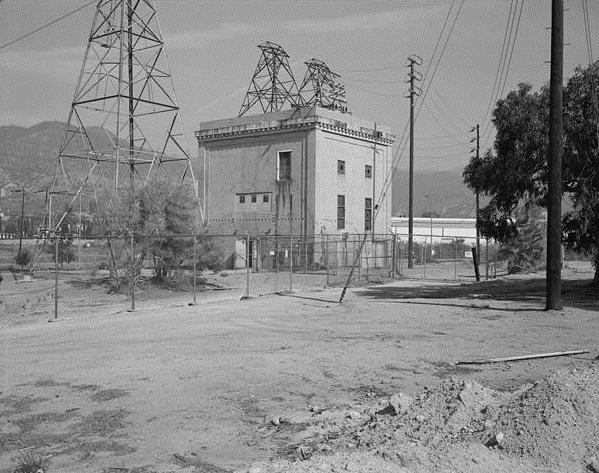 |
|
| (1917)* - Exterior view of Olive Switching Station, one of the first in Southern California. |
Historical Notes On March 18, 1917 the San Francisquito Power Plant No. 1, Unit 1 was placed in service and energy was delivered to Los Angeles over a newly constructed 115 kV transmission line. The 200 kilowatts generated by Unit 1 were the first commercial kilowatts generated by the Los Angeles Bureau of Power and Light. The Olive Switching Station was constructed between 1916 and 1917 at the mid-point of the 115 kV transmission line from San Francisquito Power Plant No. 1 to the central receiving station in the city (now Receiving Station A). Its main purpose is to ensure the reliability of the system by allowing a section of any circuit on which trouble develops to be cut out without affecting service. ** |
Olive View Switching Station (3 views)**
 |
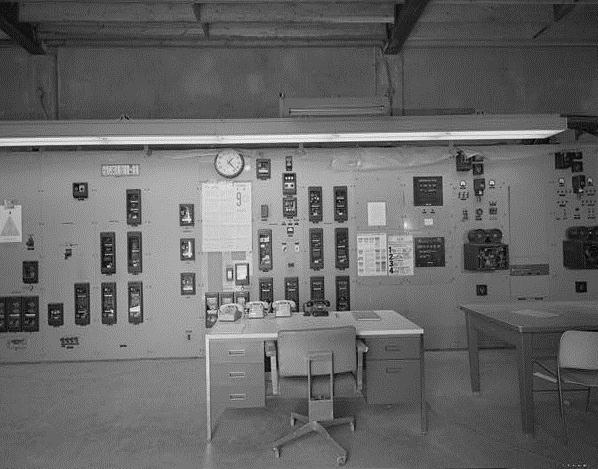 |
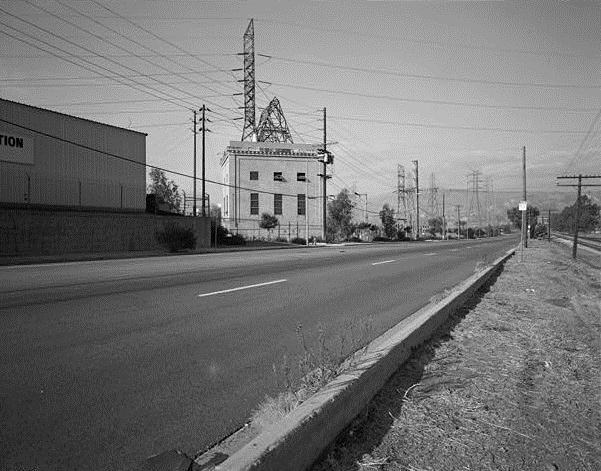 |
| South Corner View | Control Panel Room | Northeast View |
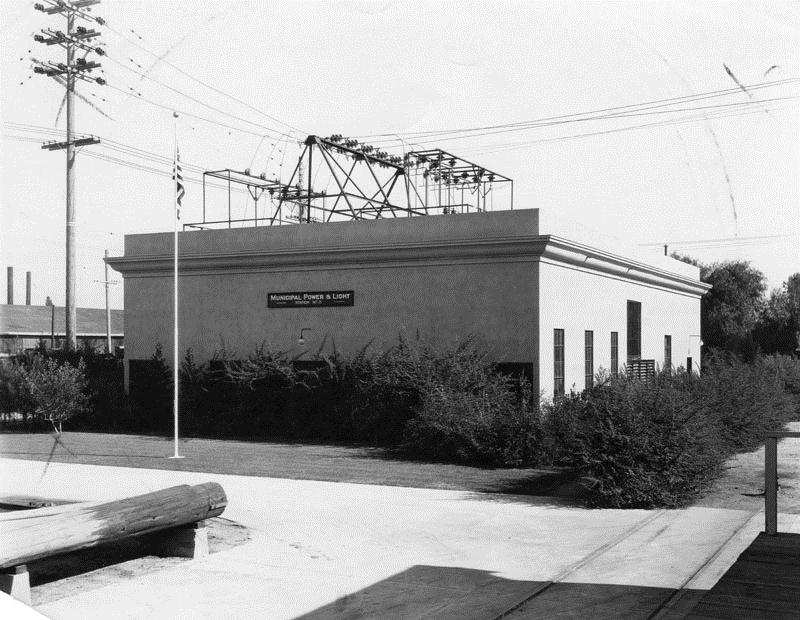 |
|
| (1929)* - Exterior view of Municipal Power & Light Station No. 2, a substation in Van Nuys. |
Victorville Switching Station
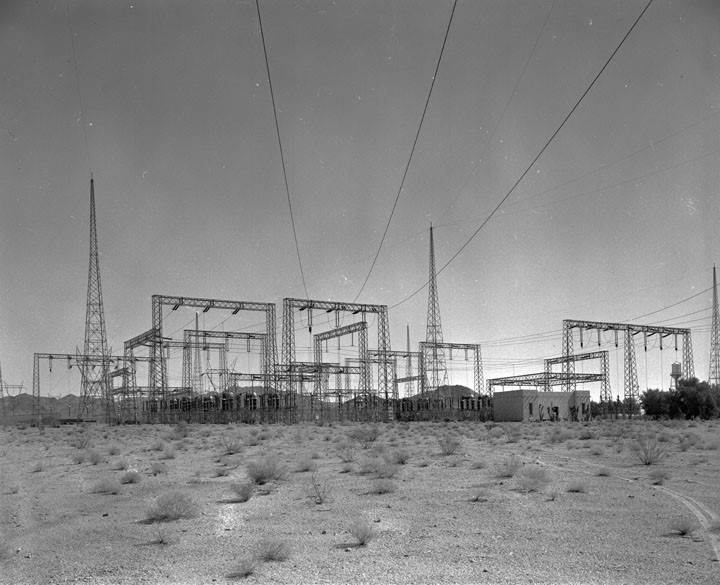 |
|
| (1936)* – View of the Victorville Switching Station. |
From the LADWP Historic Archive October 1936 – Two of the world’s most modern switching stations, each costing approximately $1,000,000, divide the Boulder transmission line into three equal parts. Both are of the outdoor type and located at Victorville and Silver Lake in the desert section of the line route. Because of the unusual length of the line, 266 miles, the stations are of vital necessity in assuring the utmost in continuity of service.^* |
 |
|
| (1930s)* - Victorville Switching Station - Electrical equipment - never sleeping sentinels which guard the 266- mile Boulder transmission line are these giant circuit breakers, largest ever built at the time, that are an integral part of the Victorville Switching Station. |
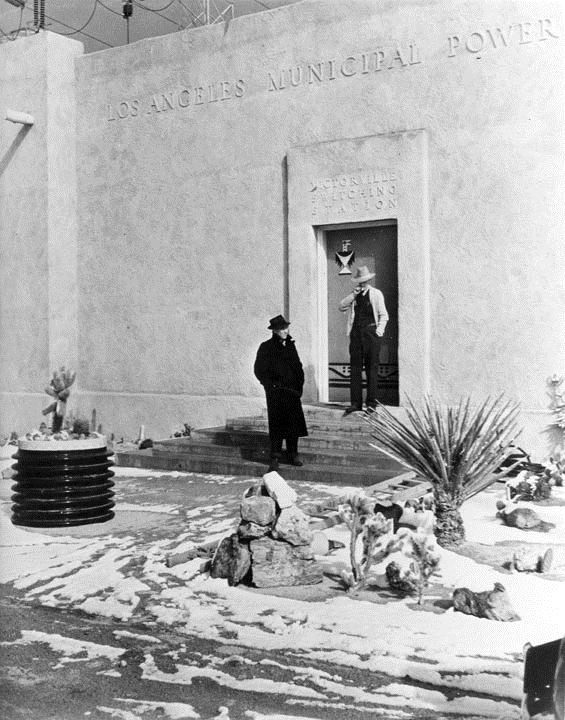 |
(1930s)* - Entrance to the Bureau of Power and Light's Victorville Switching Station after a snow storm.
|
Silver Lake Switching Station
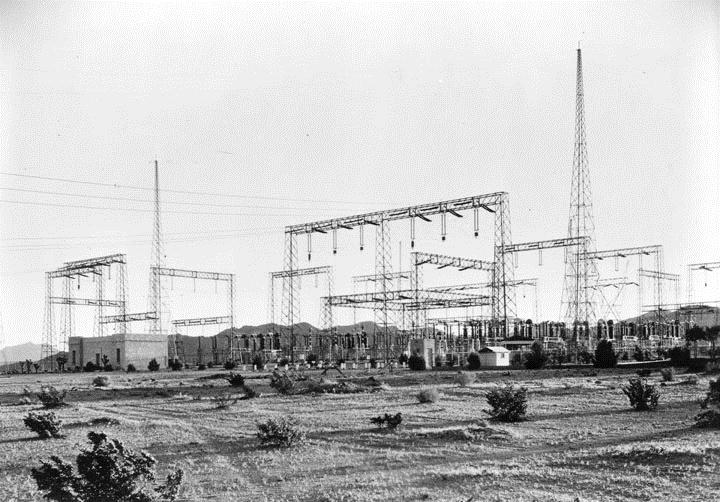 |
|
| (1930s)* - Bureau of Power and Light Silver Lake Switching Station. |
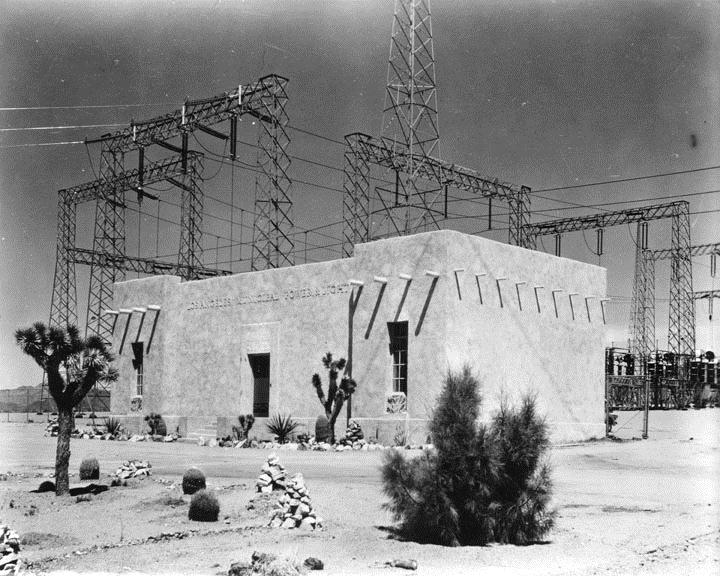 |
|
| (1930s)* - Control house of the Silver Lake Switching Station - Bureau of Power and Light*. |
Historical Notes * In 1937 the Bureau of Power and Light consolidated with the Bureau of Water Works and Supply and became the Los Angeles Department of Water and Power (DWP). This coincided with the completion of Hoover Dam. Los Angeles got its first electricity from Hoover Dam on October 9, 1936. Click HERE to see DWP Name Change Chronology (1902 to present). |
* * * * * |
DWP Receiving Stations
There are 23 receiving stations in the DWP system. Most of them are designated by a letter in the alphabet, reflecting the sequence in which they were built, and most also have a name, usually derived from a nearby street. Each receiving station has racks and rows of high voltage equipment in a yard larger than a few city blocks, and usually a control house facing the street, designed to reflect the architectural styles and aspirations of the time it was built.*# |
Receiving Station B
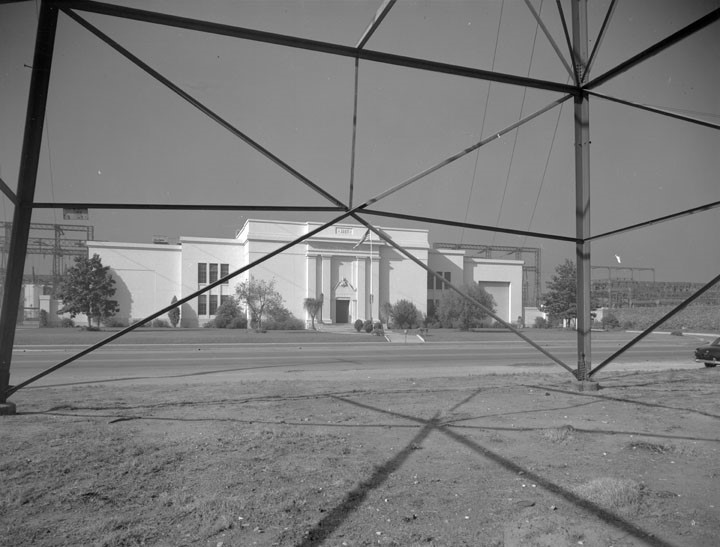 |
|
| (1927)* - View through a transmission line tower of Receiving Station B located at 9615 S. Central Ave. |
From the LADWP Historic Archive November 1927, to meet the needs of thousands of heavy industrial plants in the southeast and Harbor districts of the City, the Municipal Bureau of Power and Light placed in full operation, on October 12th, 1927 two new receiving power stations, involving an investment of $2,250,000. The first of the new power stations is situated at 95th Street and Central Ave; the second in Wilmington in the Harbor District. These stations it was explained by Chief Electrical Engineer E. F. Scattergood, of the Power Bureau, will serve as the first large units of a gigantic high voltage electric belt line which, when completed, will entirely encircle Los Angeles, and is now under construction by the Bureau. Approximately 300,000 horsepower of electric current, or enough energy to duplicate the work of 2,400,000 men, can be handled and distributed to industrial and domestic consumers through the new stations which are designated as Receiving Stations B and C. Prior to the completion of the new receiving stations, the Bureau received all of its power generated along the Aqueduct it its Central Station A on North Main Street. With the new stations in operation, energy is supplied to the Southwest industrial district and the Harbor zone directly from the Aqueduct transmission lines and by the lines of the private power company from whom the City purchases a portion of its electricity. Designed to be capable ultimately of handling 320,000 horsepower of electric energy each, the stations are now operating with a capacity of approximately 150,000 horsepower each, it was explained by Power Bureau engineers. Station B in the Southeast section of the city, it was stated, involved an investment of $1,500,000 while Station C, with a portion of its machinery still housed in temporary structures, cost $750,000. With the new receiving stations in operation, Mr. Scattergood pointed out, the Municipal Power Bureau is able more economically and efficiently to carry large volumes of electric power to the very heart of heavy consuming areas. These stations receive electric energy raised to a voltage varying from 132,000 volts to 33,000 volts. After passing through the huge stations the energy is reduced to those lower voltages required by factories, stores and homes. The high voltage belt line, of which the new stations are the first units to be completed, will carry high voltage energy by means of cables on tall steel towers in a great circle around the city of Los Angeles. from this electric belt line, which serves the same purpose as a railroad belt line, energy will be taken off at regular points and, after being reduced to the proper voltages, relayed to consumers. Use of such a high voltage belt line, it was pointed out by engineers, will eliminate the necessity of having hundreds of lower voltage pole lines running along the streets in practically every section of the city. The belt line and Receiving Stations also will insure greater reliability of service and will efficient method of conveying large blocks of electric power to the large consuming districts, engineers explained.^* |
 |
|
| (1936)* - World’s largest circuit breakers shown being assembled at Receiving Station B for reception of Boulder Dam power. |
Substation Elements
 |
|
| Electrical Substation Model |
Elements of a Substation |
Station Transformers and Equipment
 |
|
| (1935)* - Huge 30 ton crane successfully undergoing test at Main Street Yards. Note the crane operator just visible in control box in upper right corner. Capable of hoisting a dead load of 30 tons, one of two new cranes for the Power Bureau’s transformer warehouse at 1630 North Main Street is now in active service. The crane will be able to handle the larger transformers to be used in The Bureau's new substations. |
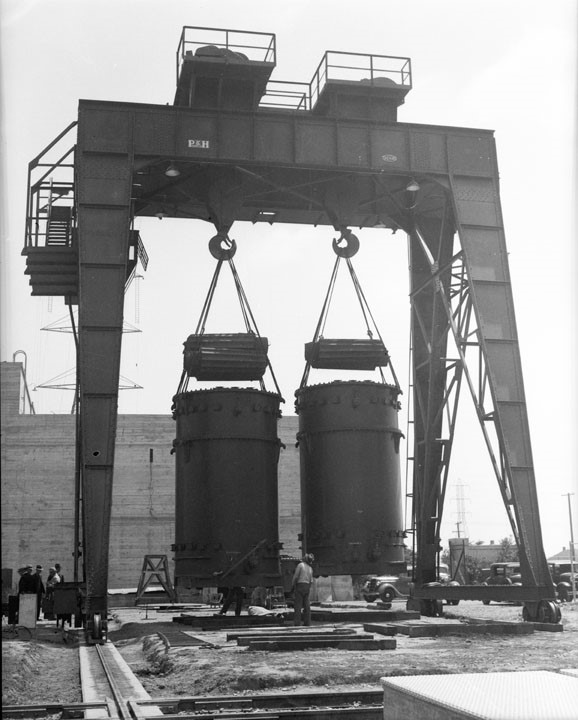 |
|
| (1936)* – Close-up view showing testing of the new Gantry Crane at Receiving Station B. |
From the LADWP Historic Archive Constructed for the express purpose of moving the immense auto transformers which constitute the receiving end of the 275,000 volt Boulder Canyon transmission line, a giant 150 ton Gantry crane now is ready for its acceptance tests at Receiving Station “B”. instead of being constructed with a stationary frame-work and traveling bridge, as is the case with the crane equipment at Station “A”, the four legs of the Gantry crane are mounted on wheels so that the entire unit may be moved the entire length of the crane track. Towering to an overall height of 53 feet, the unit has a vertical lift of 40 feet. It weights 100 tons, which is less than half of its lifting capacity. Although rated at 150 tons, the crane can lift an overload of 25 per cent with its two huge hooks. The span from rail to rail is 35 feet. The crane cost, including erection, was $33,285, according to Carl D. Udell who was in charge of preparing the specifications for the hoisting unit. It will be powered by two 40 horsepower and one 30 horsepower electric motors. Because of the tremendous weight of the crane when loaded to capacity, special care was used in the structural design of the 173 foot long runway on which the crane travels. According to V. Lankovsky, who supervised the preparation of plans, the runway was designed to sustain a load of 300 tons. In constructing the runway, a shallow trench was excavated to a depth of four feet. Thirty-foot piles then were driven into the ground at intervals of three feet. They were capped with concrete and upon this base reinforced concrete beams 30 inches wide and 48 inches deep were poured to form the support upon which the crane rails were to rest. Nine tie beams, 16 inches square, form rigid cross bracing support. At one end of the track a transformer pit is being constructed. It will be 21 feet square and 16 feet deep, sufficiently large to accommodate any one of the auto transformers. Walls are 6 inches thick and fully reinforced with steel. The pit will be capped with a waterproof, removable cover.^* |
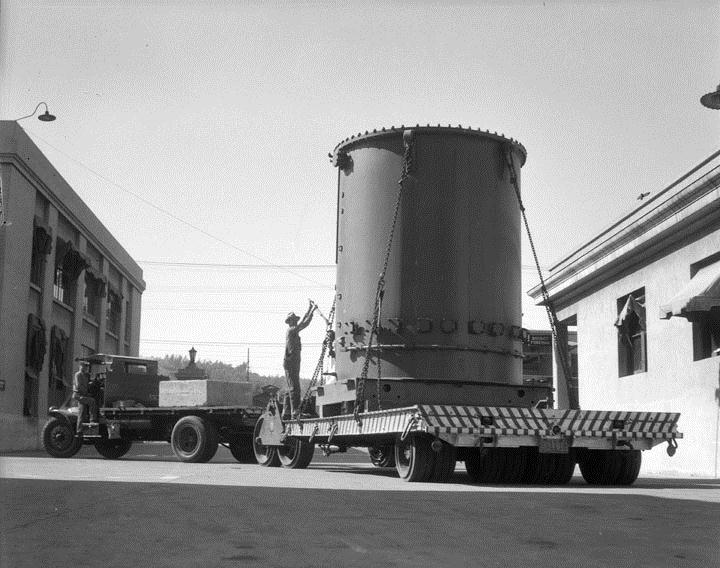 |
|
| (1936)* - Moving a 50-ton transformer from 1630 N. Main Street to Receiving Station C in Wilmington. |
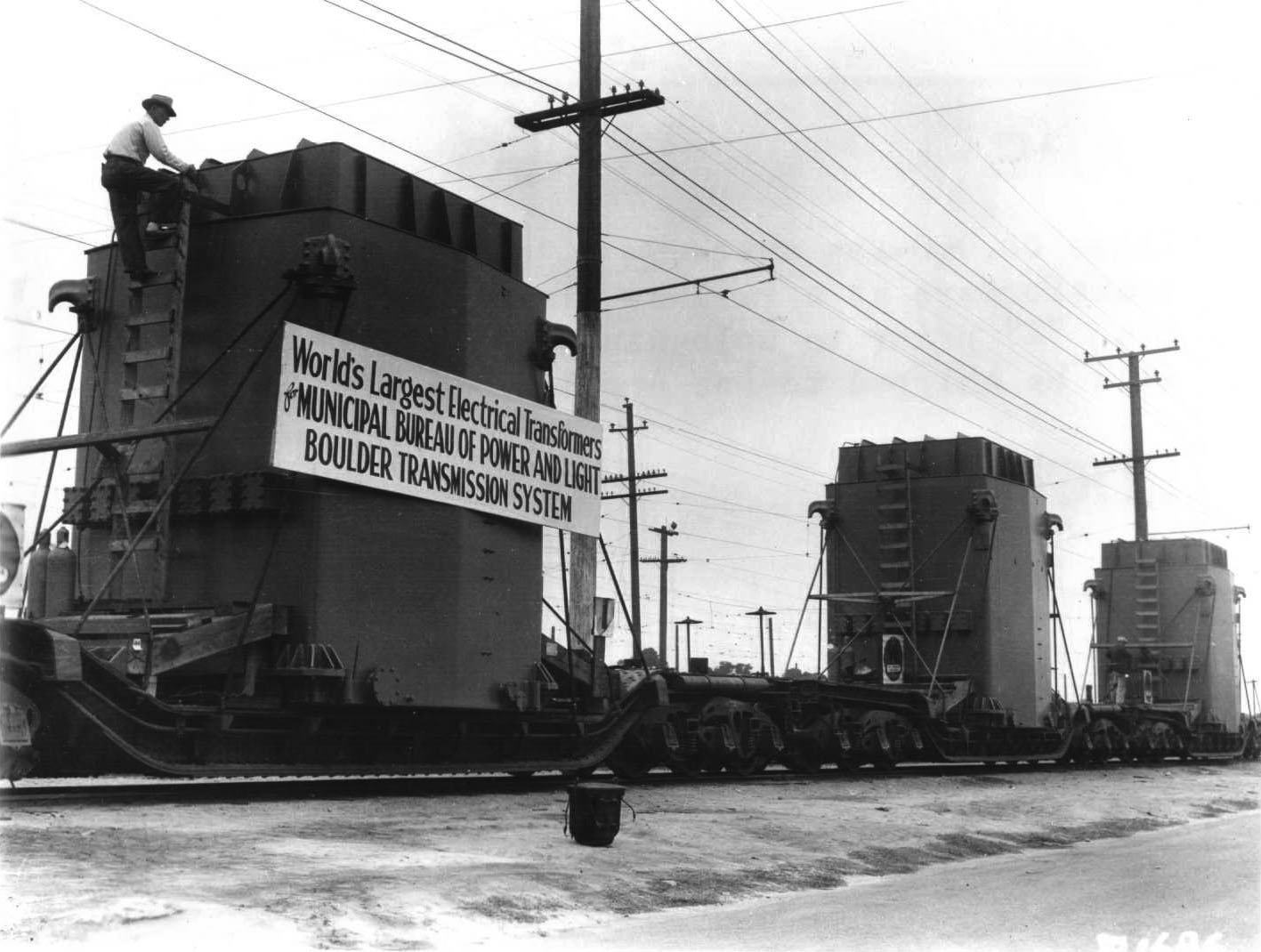 |
|
| (1936)^^ - View showing three of the boulder line transformers on heavy duty flat cars awaiting unloading. |
Historical Notes Large sign on transmorfer reads: World's Largest Electrical Tansfomers for MUNICIPAL BUREAU OF POWER AND LIGHT - BOULDER TRANSMISSION SYSTEM" Click HERE to see more in Early Power Transmission. |
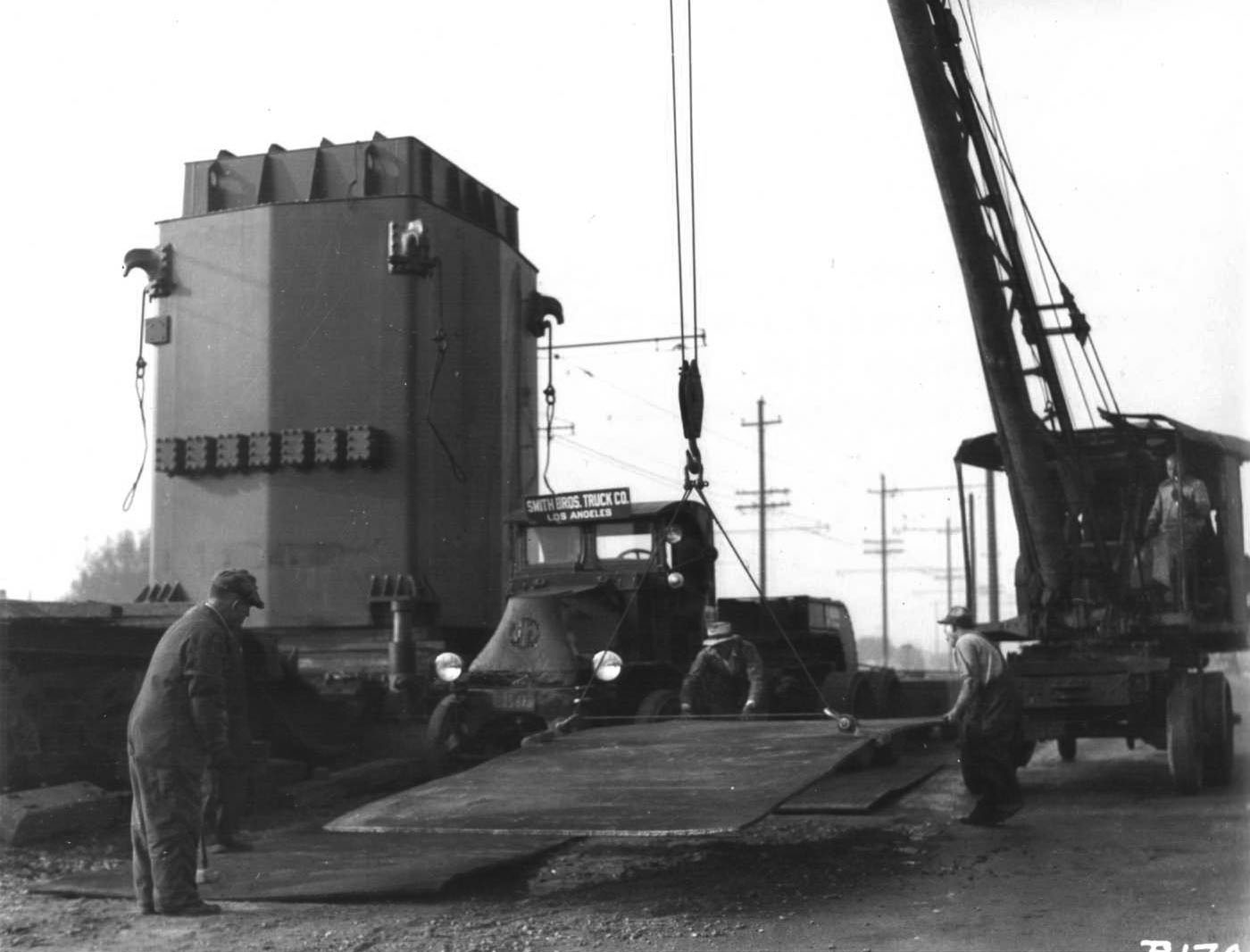 |
|
| (1936)^^ - View showing the unloading of one of the transformers. |
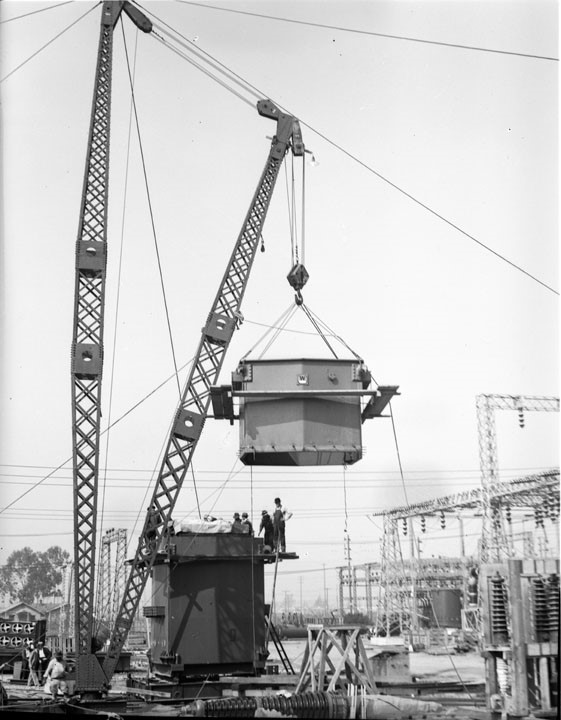 |
|
| (1936)* - Assembling a 186-ton transformer at Receiving Station B for Boulder Canyon transmission line. |
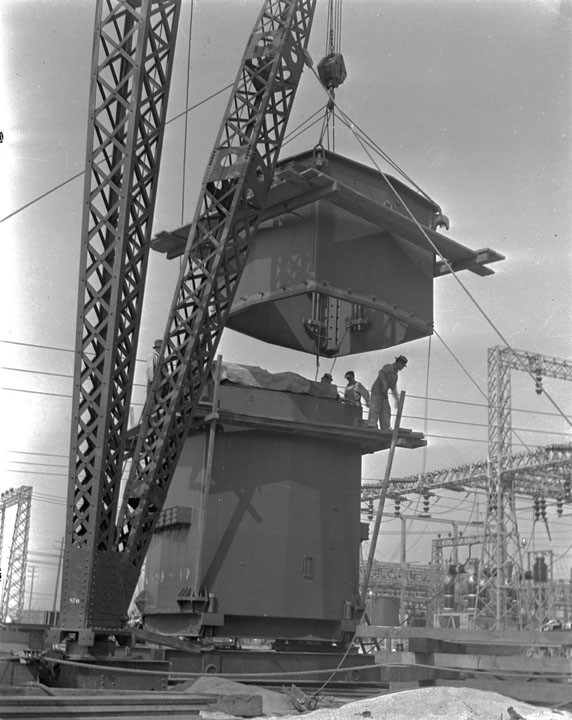 |
|
| (1936)* - Closer view showing one of seven huge 155-ton transformers being assembled at Receiving Station B – 9615 South Central Ave., for Boulder Canyon Project. |
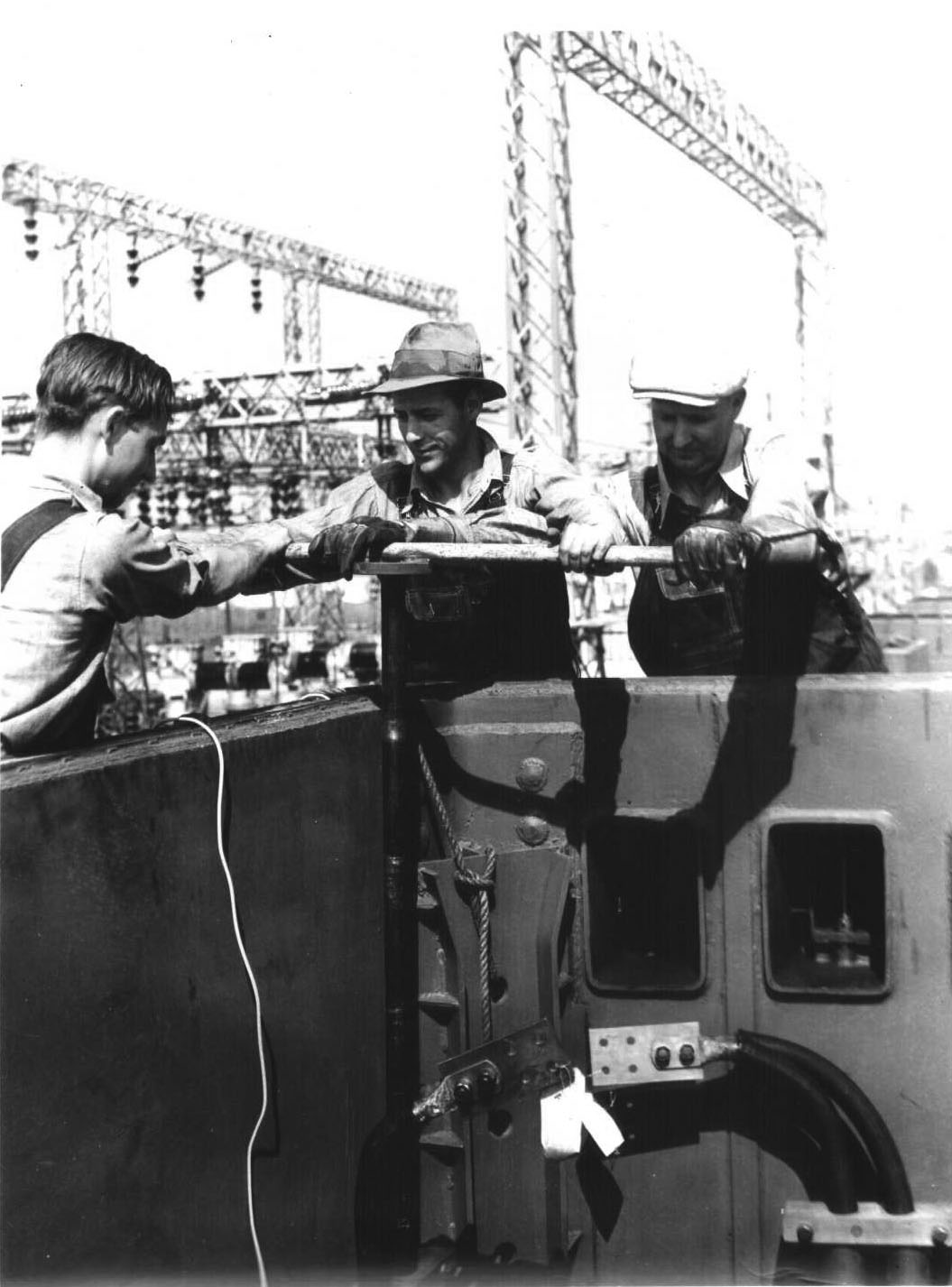 |
|
| (1936)^^ - Close-up view showing three workers assembling one of the large transformers. |
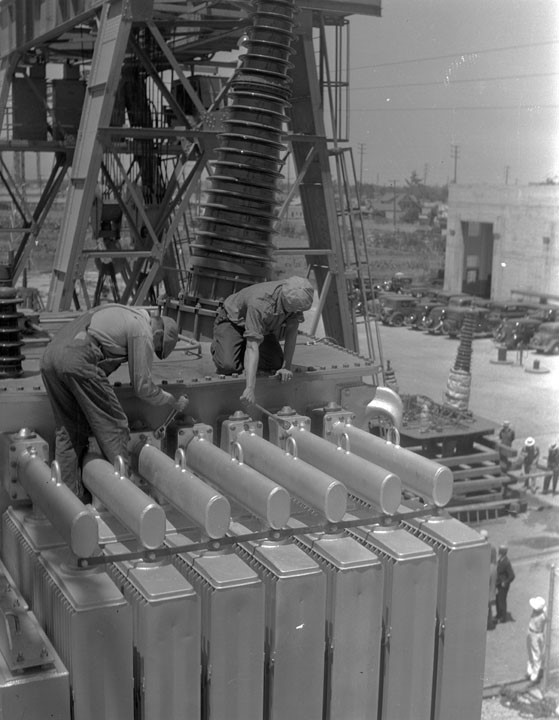 |
|
| (1936)* - Assembling 186-ton Boulder Canyon transmission line transformer at receiving station B workmen are shown attaching huge cooling fins to the body of a transformer - a total of 14 of these are required for each transformer. |
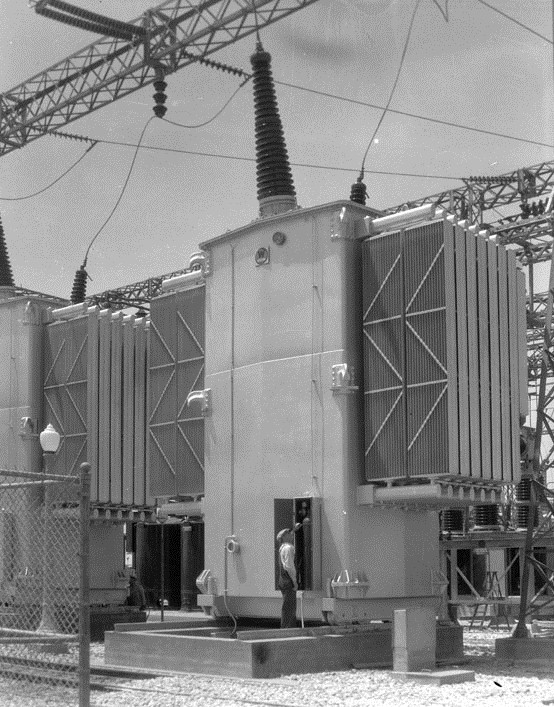 |
|
| (1936)* - 186-ton Boulder Canyon transmission line transformer at Receiving Station B. |
LADWP Historic Archive October 1936 – Terminus of the Boulder transmission line is Receiving Station ‘B’ located at 96th Street and Central Ave. As Boulder power enters the six huge 186-ton transformers, shown below, it starts through the first of several voltage “step-downs” before reaching Power Bureau consumers. |
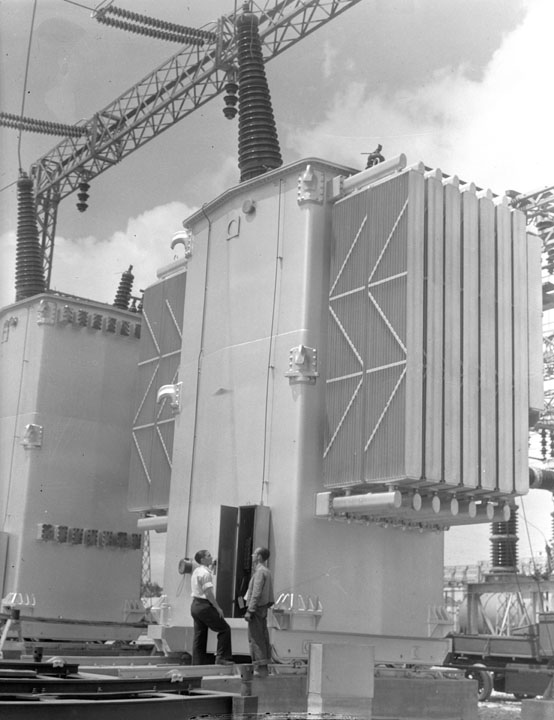 |
|
| (ca. 1936)* - At the time these were the world’s largest transformers. They were installed at Receiving Station B for the Boulder Canyon Transmission Line. |
Historical Notes Six of these 186-ton transformers were required for proper operation of 266-mile transmission line. In 1936, they constituted the largest installation in the world, both from the standpoints of size and capacity. Each occupied a ground space of 11 ½ ft. x 23 ½ ft. and towered 36 ft. into the air. Each transformer and appurtenant equipment weighed approximately 170 tons, consisting in part of seven tons of copper, 47 tons of electrical sheet steel, nine tons of insulating material, 53 tons of coil and 15,000 gallons of transformer oil.* |
 |
|
| (1936)* - Boulder Canyon transmission line circuit breakers installation at Receiving Station B. |
Historical Notes At the time these were the world's largest insulators.^* |
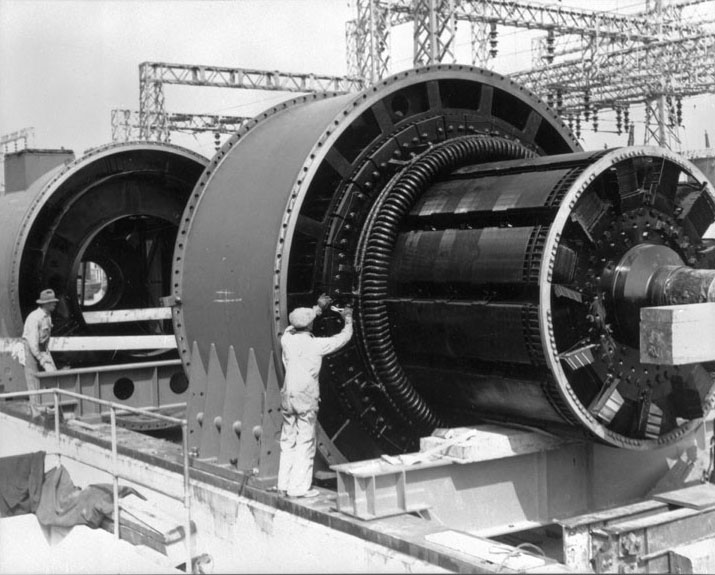 |
|
| (1936)* - Assembling the giant stator and rotor units of the condenser. Their combined weight is 165 tons. When in operation, the condenser will control the voltage and power factor of the Boulder Canyon Transmission System. |
LADWP Historic Archive The synchronous condenser units control the power factor and voltage of the transmission line. When erected on its reinforced concrete foundation at Receiving Station “B” the condenser will measure approximately 28 feet in length and 15 feet in diameter. Designed for outdoor use, operating parts will be enclosed so that the unit will resemble an enormous tank lying on its side. Foundation walls enclose a pit under the machine which will house auxiliary equipment such as the motor generator excitor sets.^* |
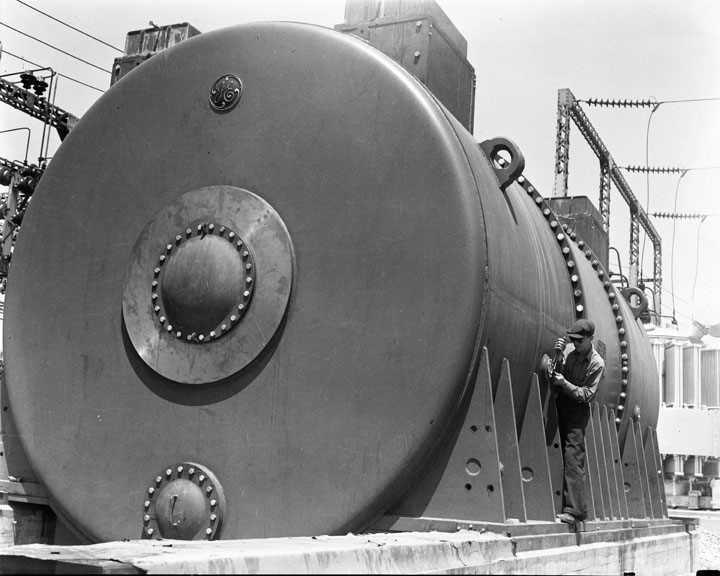 |
|
| (1936)* - Synchronous condenser installation at Receiving Station ‘B’. |
LADWP Historic Archive Data supplied by J. P. Stratford who was in charge of preparing the specifications from which the condenser was fabricated, rates the capacity of the machine from 60,000 kva leading to 30,000 kva lagging power factor, thus permitting a total range of 90,000 kva. Operating voltage is 13,200 at 60 cycles. Contract price of each machine was $250,000 exclusive of installation costs. By controlling the voltage and power factor of the transmission line, the condensers provide an important link in assuring the highest possible efficiency in line operation.^* |
 |
|
| (ca. 1936)^^ - J. A. Griffitts opening the circuit breaker on the last DWP 50 cycle circuit. Taken in the old control house at RS-C in Wilmington. |
Historical Notes Prior to 1936, the Southland was sort of an electrical enclave. Both Edison and Los Angeles Bureau of Power and Light generated and distributed their power at 50hz where most parts of the country were at 60hz. Some electrical appliances worked at both frequencies, but for frequency-sensitive products manufacturers created special 50hz models just for the Southern California market. And when newcomers moved from outside the region, they paid to have their old devices converted, or simply bought new ones that would work on the 50hz grid. In 1936, in order to accept power from Hoover Dam's 60hz generators, the Los Angeles Bureau of Power and Light converted its entire system from 50 to 60hz. It would take Southern California Edison another 12 years (1948) before they would also convert to 60hz.*^ |
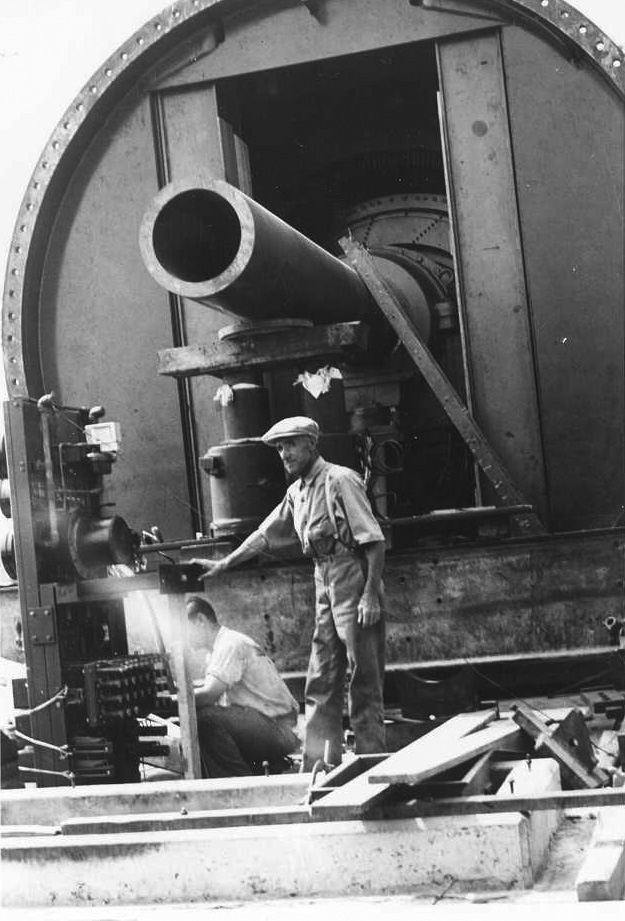 |
|
| (1936)^^ - View showing the Frequency Changer at RS-C in Wilmington. |
Historical Notes This machine was basically two synchronous condensers, one wound for 50 cycles and the other for 60, mechanically coupled and operating in a single hydrogen-filled shell. This unit was installed in preparation for the BP&L 60 cycle cutover to allow a connection between the Bureau's 60 cycle system and Southern California Edison's 50 cycle system. After Edison's conversion to 60 cycles, the 60 cycle unit stayed at RS-C to become Condenser C and the 50 cycle unit was moved to Receiving Station D to become Condenser B. The unit was water-cooled and the cooling towers were located in an underground vault. The vents for the cooling towers are in the structure at the left edge of the picture.^^ |
.jpg) |
|
| (1936)^^ - Interior view showing the spacious and well-lit control room at RS-B. |
From DWP's Historic Archives October 1936 – Operation and maintenance of the Boulder transmission system is a function of the Bureau of Power and Light Operation Division, headed by T. A. Panter. In addition, this division will have direct charge of operating the giant 115,000 horsepower generators at Boulder Dam that will generate power for Los Angeles and all other public agencies that have contracted for Boulder power. This represents 91 per cent of the Plant’s 1,835,000 horsepower capacity.^* |
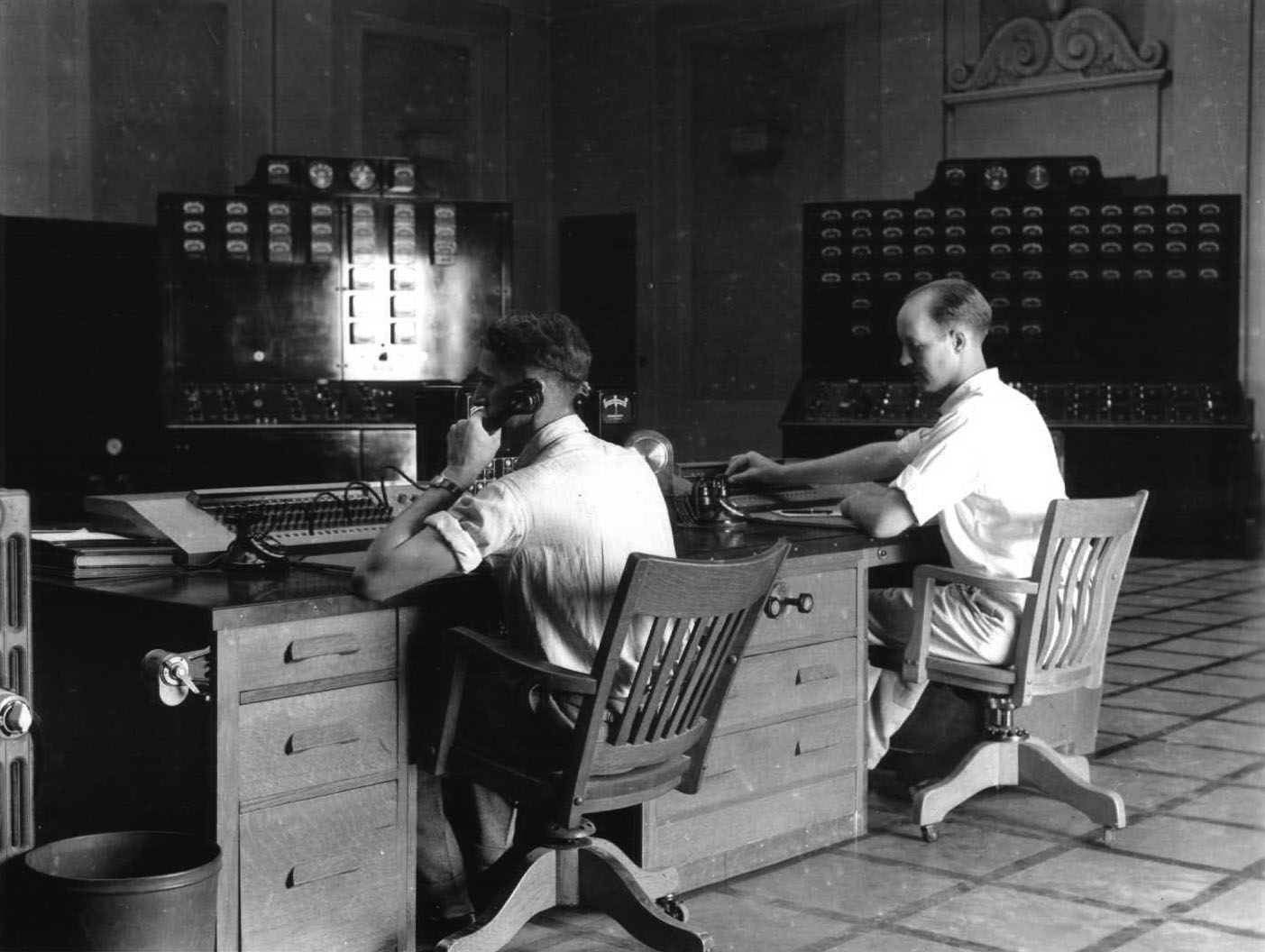 |
|
| (1936)^^ - Close-up view showing two operators sitting at the control desk at RS-B. |
From DWP's Historic Archives For maximum operating efficiency the most modern control and communication systems available have been installed. This equipment, costing $430,000, provides control of automatic relays that operate in split-second speed to clear line faults; gives supervisory control of switching operations at stations 90 and 180 miles from the Power Plant; keeps switching stations, local load dispatchers office, and operators at Boulder in constant telephonic communication by a carrier current system and enables patrolmen with radio equipped automobiles to receive instructions along the power line route similarly to radio police methods.^* |
 |
|
| (1936)^^ - A station operator standing in front of the control board for 34.5-kV Section C at RS-B. |
From DWP's Historic Archives Indicating lamps in the local dispatchers’ office will show at all times the open or closed positions of switches throughout the entire transmission system. Patrol cars will cover the 266 mile route daily and specially equipped trucks will be stationed at intermediate points to made emergency repairs that may be required. At Boulder City, 27 additional residences are being planned to house employees there, bringing to 66 the total number of houses and dormitories required for operating employees and their families at Boulder City, Silver Lake and Victorville.^* |
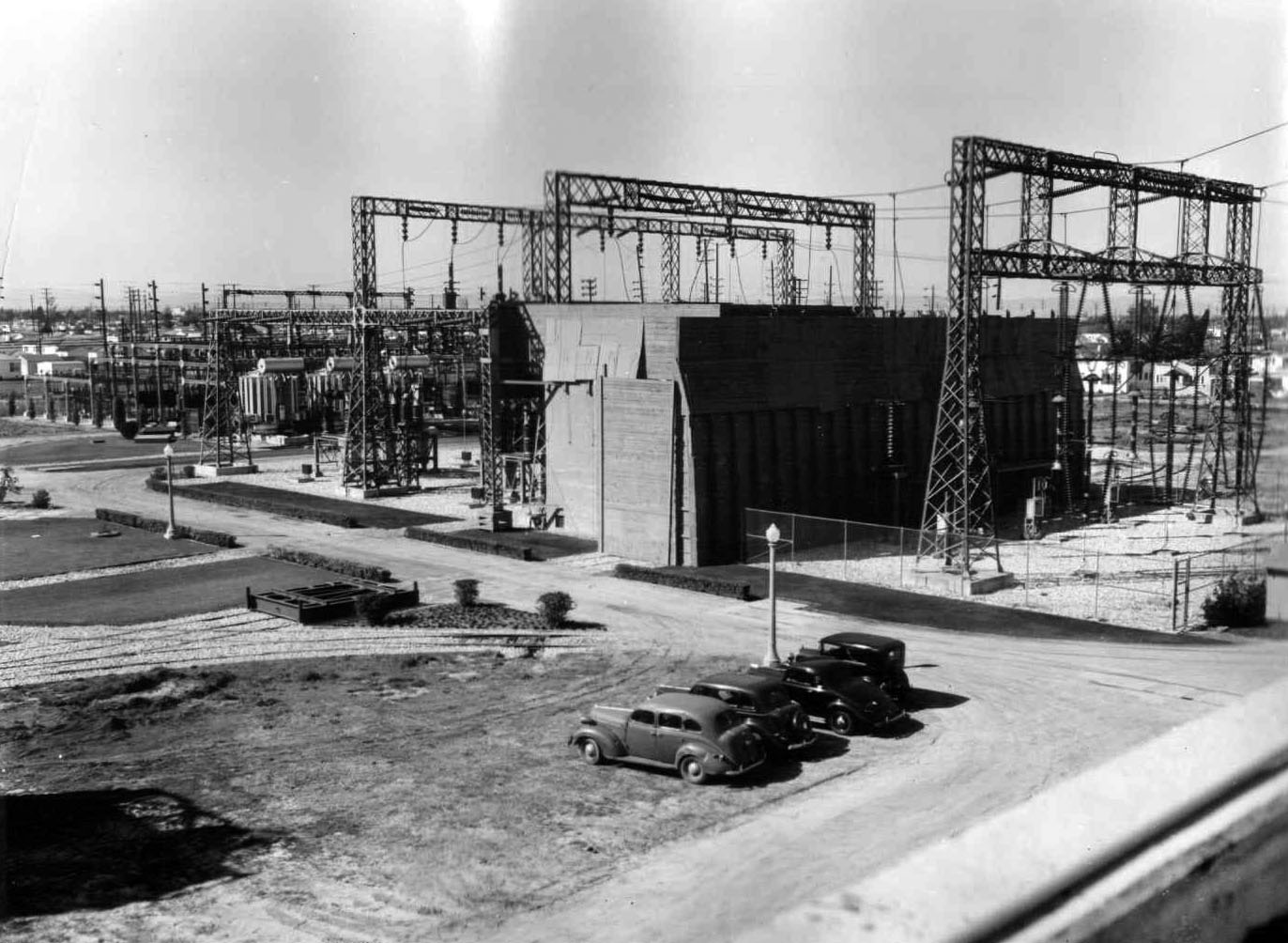 |
|
| (1942)^^ - View showing a protective enclosure around one of the Boulder Banks at RS-B, made of heavy timbers to protect them from enemy attack during WWII. Photo Date: 2-27-42 |
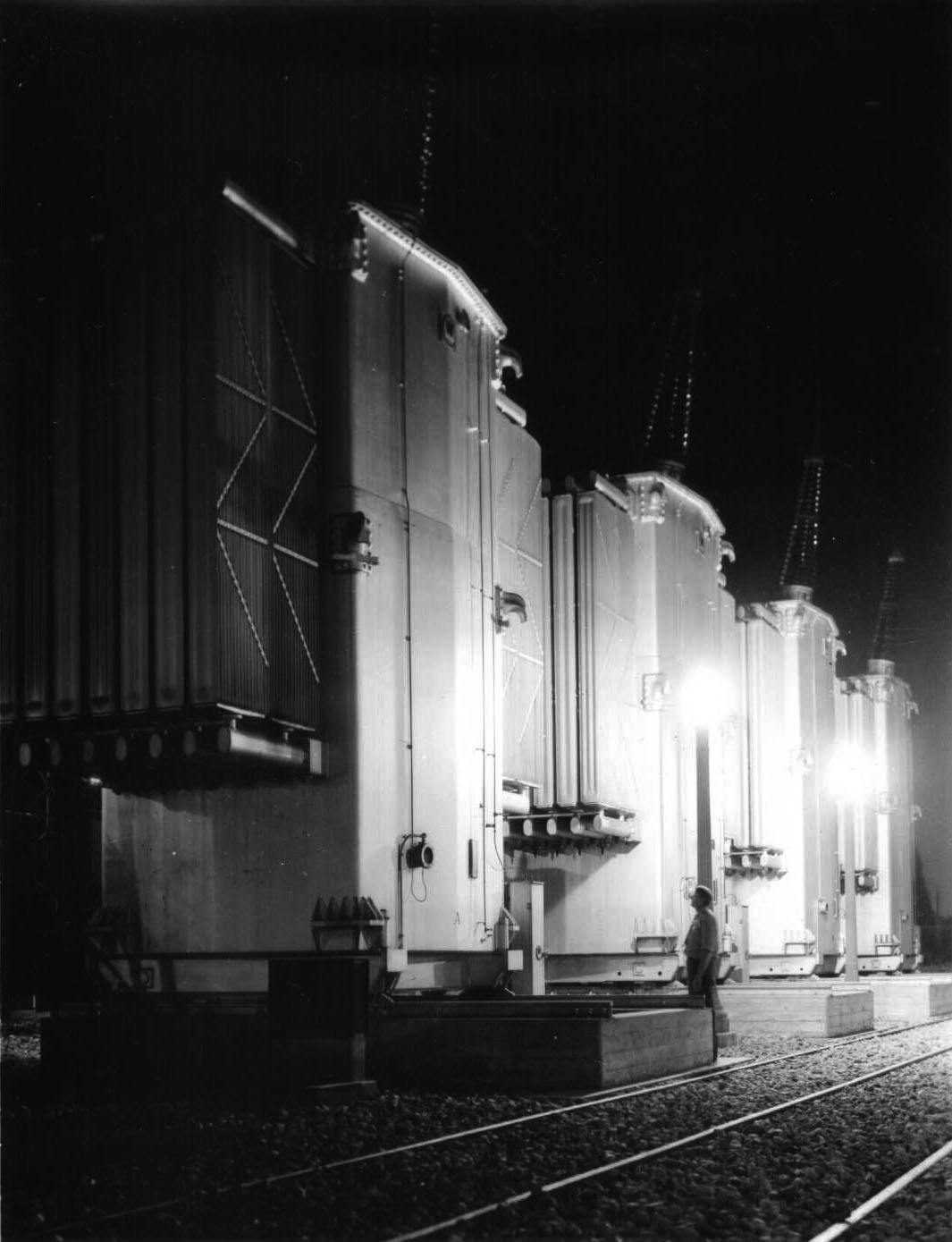 |
|
| (1947)^^ - Night shot of one of the Boulder Banks at RS-B. |
Industrial Stations
.jpg) |
|
| (1943)^^ – View showing Industrial Station 160. Note the guard tower at the left. The 13.8-kV switchrack is behind the guard tower and part of the 132-kV equipment in on the right. |
Background Information IS-160 was a temporary war-era expedient Industrial Station built to serve the Synthetic Rubber Plant. It was located off Normandie Ave., north of Torrance Blvd, near present-day Receiving Station Halldale. Along with IS-141 (ALCOA Aluminum), it was fed directly from the 132-kV system out of RS-C and had several 13.8-kV Feeders to serve the Synthetic Rubber Plant and other nearby defense industries. To conserve steel during the war, the 13.8-kV switchrack was made of wood.^^ |
 |
|
| (1943)^^ – View of part of the 132-kV equipment at IS-160. There is an oil circuit breaker in the center rear and part of one of the transformers can be seen at the right edge. |
.jpg) |
|
| (1943)^^ - Aerial close-up view of the wooden 13.8-kV switchrack at IS-160. |
Background Information IS-160 was finally taken out of service about 1975 with the wooden switchrack in use up to the end.^^ |
.jpg) |
|
| (ca. 1943)^^ - Operator Roy Stoutsenberger in the control room. To his left is the 132-kV control board and in from of him is the 13.8-kV control board. Note the empty KWH meter sockets at the top of the 13.8-kV board; when these pictures were taken the station was still under construction. |
Click HERE to see more in Early Power Station Operations |
* * * * * |
History of Water and Electricity in Los Angeles
More Historical Early Views
Newest Additions
Early LA Buildings and City Views
* * * * * |
References and Credits
* DWP - LA Public Library Image Archive
**Library of Congress Digital Archive
^^DWP - Water and Power Associates Historical Archives - Courtesy of Rex Atwell
*^Southland.Gizmodo.com: LA's Power Grid
*#Moving LADWP High Voltage Around
**^Wikipedia: Electrical Substation
< Back
Menu
- Home
- Mission
- Museum
- Mulholland Service Award
- Major Efforts
- Board Officers and Directors
- Positions on Owens Valley and the City of Los Angeles Issues
- Legislative Positions on
Water Issues
- Legislative Positions on
Energy Issues
- Recent Newsletters
- Historical Op Ed Pieces
- Membership
- Contact Us
- Search Index